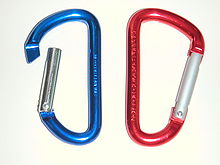Anodizing
Anodizing is an electrolytic passivation process used to increase the thickness of the natural oxide layer on the surface of metal parts.Anodizing increases resistance to corrosion and wear, and provides better adhesion for paint primers and glues than bare metal does.Anodic films are most commonly applied to protect aluminium alloys, although processes also exist for titanium, zinc, magnesium, niobium, zirconium, hafnium, and tantalum.Aluminium alloys typically form a thicker oxide layer, 5–15 nm thick, but tend to be more susceptible to corrosion.Most recently, new techniques to partially convert the amorphous oxide coating into more stable micro-crystalline compounds have been developed that have shown significant improvement based on shorter bond lengths.Anodized aluminium can be found on MP3 players, smartphones, multi-tools, flashlights, cookware, cameras, sporting goods, firearms, window frames, roofs, in electrolytic capacitors, and on many other products both for corrosion resistance and the ability to retain dye.[6] These pores are what allow the electrolyte solution and current to reach the aluminium substrate and continue growing the coating to greater thickness beyond what is produced by auto-passivation.Because the dye is only superficial, the underlying oxide may continue to provide corrosion protection even if minor wear and scratches break through the dyed layer.[citation needed] Conditions such as electrolyte concentration, acidity, solution temperature, and current must be controlled to allow the formation of a consistent oxide layer.Harder, thicker films tend to be produced by more concentrated solutions at lower temperatures with higher voltages and currents.The reason for combining the processes can vary, however, the significant difference between anodizing and chromate conversion coating is the electrical conductivity of the films produced.None of these specifications define a detailed process or chemistry, but rather a set of tests and quality assurance measures which the anodized product must meet.It is widely known as the Bengough-Stuart process but, due to the safety regulations regarding air quality control, is not preferred by vendors when the additive material associated with type II doesn't break tolerances.[6] Shades of color are restricted to a range which includes pale yellow, gold, deep bronze, brown, grey, and black.Also, if the current or voltage are driven too high, 'burning' can set in; in this case, the supplies act as if nearly shorted and large, uneven and amorphous black regions develop.In these processes, the coating growth stops when the part is fully covered, and the thickness is linearly related to the voltage applied.[6] This type of coating is widely used to make electrolytic capacitors because the thin aluminium films (typically less than 0.5 μm) would risk being pierced by acidic processes.[17] Thicker coatings of 25 μm and up can provide mild corrosion resistance when sealed with oil, wax, or sodium silicate.Niobium anodizes in a similar fashion to titanium with a range of attractive colors being formed by interference at different film thicknesses.Tantalum anodizes similarly to titanium and niobium with a range of attractive colors being formed by interference at different film thicknesses.AMS 2488 Type II anodizing produces a thicker matte grey finish with higher wear resistance.[17] A solution of ammonium phosphate, chromate and fluoride with voltages of up to 200 V can produce olive green coatings up to 80 μm thick.[22] The most common anodizing processes, for example, sulphuric acid on aluminium, produce a porous surface which can accept dyes easily.The most common colors in the industry, due to them being relatively cheap, are yellow, green, blue, black, orange, purple and red.The color resulting from interference shifts from blue, green, and yellow to red as the deposited metal layer thickens.Interference-colored anodized aluminum parts exhibit a distinctive quality: their color varies when viewed from different angles.Integral color anodizing produces no VOCs, heavy metals, or halogens as all of the byproducts found in the effluent streams of other processes come from their dyes or plating materials.




carabinerselectrolyticpassivationelectrolytic cellcorrosionlight wave interferencegallingelectrolytic capacitorsaluminium alloystitaniummagnesiumniobiumzirconiumhafniumtantalumcarbon steeliron oxideferric hydroxidehydrated iron oxidesulfatechloridehigh-carbon steelcast ironFerrous metalsnitric acidred fuming nitric acidIron(II,III) oxidecrystal structurecorrosion resistanceDuraluminseaplanechromic aciddefence specificationplasticspowder coatingRaspberry Pi 4heat sinkdyeinglubricationadhesioninsulativeself-passivatesamorphousaluminium oxidecoppersilicon2000-, 4000-, 6000 and 7000-series Al alloysMP3 playerssmartphonesmulti-toolsflashlightscookwarecamerassporting goodsfirearmswindow framesthermal stressdirect currenthydrogencathodeoxygenAlternating currentacidicdissolvessubstratemicrometerschromate conversion coatingU.S. military specSulfuric acidmalic acidoxalic acidsulfonatedaromatic compoundssulfosalicylic acidboratetartratePlasma electrolytic oxidationvoltagessodium silicatejewelrycommemorative coinstantalum capacitorscostume jewellerywedding ringsInternational Lead Zinc Research Organizationammonium phosphatechromatefluoridegalvanized steelsodium hydroxidesodium nitritenickel sulfateiPod Miniinorganicferric ammonium oxalatelightfastchampagneBronzearchitectural metalsorganic acidssulfurichydratedTeflonnickel acetatedichromatepanel edge stainingheavy metalshalogensvolatile organic compoundsaluminium hydroxidealuminium sulfateindustrial wastewater treatmentthreadedscrewsBlack oxidePhosphate conversion coatingWayback MachineBibcodeASM InternationalPopular Science